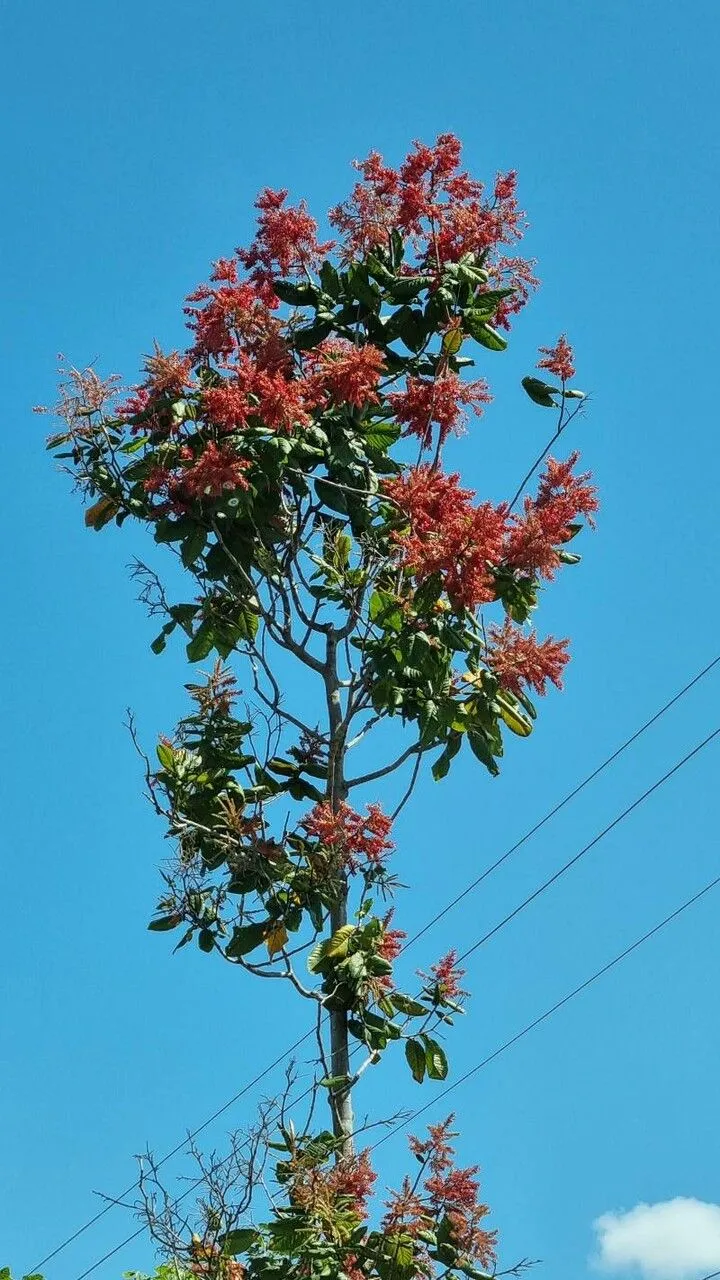
Author: L.
Bibliography: Syst. nat. ed. 10, 2:881. 1759
Year: 1759
Status: accepted
Rank: species
Genus: Triplaris
Vegetable: False
Observations: Mexico (Chiapas) to S. Trop. America
Triplaris americana, commonly known as the Ant-tree, is a fascinating species within the family Polygonaceae. This remarkable tree is native to a wide range extending from Chiapas in Mexico down to Southern Tropical America. Recognized scientifically by Linnaeus in his 1759 edition of “Systema Naturae,” the Ant-tree has a unique ecological relationship with ants, which is a notable aspect of its biology and contributes to its common name.
The Ant-tree can often be identified by its tall, slender silhouette, usually reaching impressive heights that make it stand out in tropical forests. The leaves are long and lanceolate, with a glossy surface that captures sunlight efficiently, helping the tree thrive in its warm, sunny habitats. Flowers of Triplaris americana are small yet numerous, creating striking inflorescences that are not only attractive but also important for the local ecosystem.
A particularly intriguing characteristic of the Ant-tree is its symbiotic relationship with ants. The tree has hollow stems that provide ants with a habitat. In return, the ants offer protection by aggressively deterring herbivores and other potential threats. This mutualistic relationship exemplifies a fine balance of nature, where both the flora and the fauna benefit significantly. The ants, attracted to a sugary secretion from the tree, fiercely guard their territory, ensuring that the Ant-tree remains unharmed from leaf-eating insects and other animals.
This natural defense mechanism allows Triplaris americana to flourish in environments where other plants might struggle due to predation. Consequently, the Ant-tree often forms dense stands, dominating the landscape wherever it grows. Its presence is an indicator of a healthy ecosystem, supporting a variety of wildlife and contributing to the biodiversity of tropical regions.
In addition to its biological and ecological significance, the Ant-tree has been utilized in traditional medicine and local practices. Various parts of the plant are harvested for their therapeutic properties, though scientific studies on its efficacy are limited. Nevertheless, it remains a valuable resource for indigenous communities throughout its range.
Triplaris americana, with its distinct features and vital ecological role, continues to be a subject of interest for botanists and ecologists. Its resilience and adaptability make it a critical species for studying plant-insect interactions and forest dynamics in tropical ecosystems.
Eng: ant-tree, triplaris
En: Ant-tree, Triplaris, Ant tree
Ar: تربلارس أمريكي
Pt: Pau-formiga
© copyright of the Board of Trustees of the Royal Botanic Gardens, Kew.
© copyright of the Board of Trustees of the Royal Botanic Gardens, Kew.
© copyright of the Board of Trustees of the Royal Botanic Gardens, Kew.
Taken May 25, 2022 by Drica Oliveira (cc-by-sa)
Taken Feb 16, 2022 by Serv Priv (cc-by-sa)
Taken Sep 7, 2021 by Carosin Jean Pierre (cc-by-sa)
Taken Sep 7, 2021 by Carosin Jean Pierre (cc-by-sa)
Taken Sep 19, 2021 by Ferraz Rafael (cc-by-sa)
Taken Aug 14, 2019 by Elisa (cc-by-sa)
Taken Nov 21, 2021 by Gustavo Fiedler Rossi (cc-by-sa)
Taken Nov 21, 2021 by Gustavo Fiedler Rossi (cc-by-sa)
Taken Jun 1, 2022 by Jacques Malchaire (cc-by-sa)
Taken Sep 7, 2021 by Carosin Jean Pierre (cc-by-sa)
Taken Jul 8, 2022 by Fonseca Wendel (cc-by-sa)
Taken May 23, 2022 by Justo Fernanda (cc-by-sa)
Taken Jul 8, 2022 by Fonseca Wendel (cc-by-sa)
Taken Aug 14, 2019 by Elisa (cc-by-sa)
Taken Apr 25, 2022 by Ellen Ellen (cc-by-sa)
Taken Jul 7, 2022 by Vieira do Nascimento Paulo (cc-by-sa)
Taken Nov 21, 2021 by Gustavo Fiedler Rossi (cc-by-sa)
Taken Dec 4, 2020 by Pacheco Bruna (cc-by-sa)
Taken Aug 14, 2019 by Elisa (cc-by-sa)
Taken Dec 22, 2021 by Gloria Estefany Martinez (cc-by-sa)
Family: Myrtaceae Author: (F.Muell.) K.D.Hill & L.A.S.Johnson Bibliography: Telopea 6: 402 (1995) Year: 1995 Status:…
Family: Rubiaceae Author: Pierre ex A.Froehner Bibliography: Notizbl. Bot. Gart. Berlin-Dahlem 1: 237 (1897) Year:…
Family: Sapindaceae Author: Koidz. Bibliography: J. Coll. Sci. Imp. Univ. Tokyo 32(1): 38 (1911) Year:…
Family: Asteraceae Author: A.Gray Bibliography: Pacif. Railr. Rep.: 107 (1857) Year: 1857 Status: accepted Rank:…
Family: Fabaceae Author: Medik. Bibliography: Vorles. Churpfälz. Phys.-Ökon. Ges. 2: 398 (1787) Year: 1787 Status:…
Family: Aspleniaceae Author: (Cav.) Alston Bibliography: Bull. Misc. Inform. Kew 1932: 309 (1932) Year: 1932…